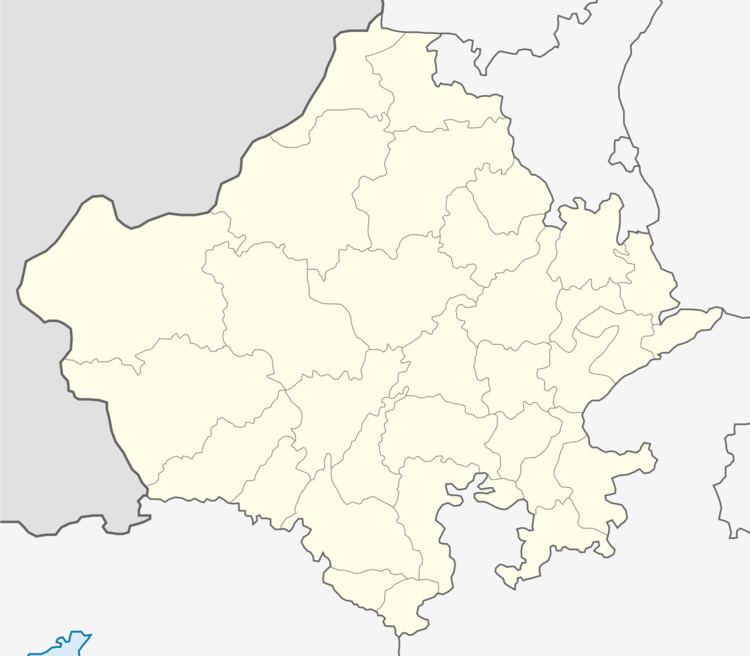District Sikar PIN 332316 Elevation 424 m ISO 3166 code ISO 3166-2:IN | Time zone IST (UTC+5:30) Telephone code 91-1573 Population 1,242 (2011) | |
 | ||
Birodi Bari (Hindi: बिड़ोदी बड़ी) or Bidodi Badi or Beerodi Badi is a village in the laxmangarh administrative region of Sikar district of Indian state Rajasthan. It lies 20 kilometres (12 mi) east of Laxmangarh and 5 kilometres (3.1 mi) west of Nawalgarh. It borders Khinwasar, Bidsar, Bidasar, Birodi Chhoti, Jhadhewa, Jogiyon ka bas, Ramsingh Pura and Bhoodha Ka Bas (Malio Ki Dhani) villages.
Contents
- Map of Beerodi Bari Rajasthan 332316
- Village government
- Villages under Birodi Bari gram panchayat samiti
- Village economy
- Climate
- Transportation
- Education
- Religion
- Society and culture
- Music and Entertainment
- Games and sports
- Festivals
- Village location
- References
Map of Beerodi Bari, Rajasthan 332316
The 500 acres (2.0 km2) village has an overall population of about 4,411 of whom 2,000 are members of the Jat ethnic group, while the main Jat gotra of the village are Bhaskar, Sunda, Godara, Jakhar, Beejala, Dudhwal, Kulhadia, Dotasara, Kansujiya, Sewada, Nehra and Repaswal. Other castes include Brahmin, Jangid, Mali, Nayak, Bhopa and Balai (956).
Village government
Birodi Badi, Birodi Chhoti, Bhoodha Ka Bas, Jhadhewa, Jogiyon ka Bas and Ramsingh Pura fall under Birodi Bari Panchayat. The current sarpanch is Rajendra Prasad Bhaskar The panchayat has 13 ward members chosen by the people through polling.
Villages under Birodi Bari gram panchayat samiti
Village economy
Some 1000 people, about 70% of the population are engaged in farming. There are ten male government teachers, five female government teachers, two physical education teachers, two nurses, six armed forces personnel, one in FCI, two staff of the Rajsthan State Road Transport Corporation RSRTC, two members of the Delhi Police, three in the RAC, Seven state policemen, four electricity department workers, three are retired (Subedar Major), five are retired Havildars, 20 work in Arab countries, one soldier is a shyopal pilania (black belt in karate) and one person works as a postman. As can be seen from these figures, only 70 villagers are employed in occupations other than agriculture.
Climate
Birodi has a hot summer, scanty rainfall, a chilly winter season and a general dryness of the air, except in the brief monsoon season. The average maximum and minimum temperatures are 28-30 and 15 - 16 degrees Celsius, respectively.
Transportation
Birodi is connected by a two lane asphalt road to Laxmangarh and Nawalgarh. Nawalgarh Railway station, 3 kilometres (1.9 mi) from Birodi is the nearest railway station, which is well connected to Jaipur, Delhi and other cities. Asphalt roads connect the village to surrounding villages and to Laxmangarh.
Camel carts and bullock carts were formerly the chief means of transportation and are being replaced by bicycles and other automobiles. Quite a few villagers walked to Nawalgarh and other surrounding places. In the rainy season, womenfolk bring grass on their heads for cows and buffaloes.
Education
The villagers claim to be fully literate while all children now attend school. However, many women remain illiterate, although literacy rates are improving. Many students of the village have obtained admission to pioneering engineering institutes through various competitions run by the IIT, AIEEE etc., as well as into medical colleges through various competitions like AIPMT, Rajasthan Pre Medical Test [1] and other exams. Some village students are studying in institutes including the Indian Institute of Technology Delhi, Jaypee Institute of Information Technology University, Noida (JIIT), Indian Institute of Technology Roorkee, MNIT, CEC,Chandigarh, Chandigarh University, Punjab Engineering College, Chandigarh, Sawai ManSingh Medical College Jaipur, Amity University Noida, Indian Institute of Management Kozhikode, Indian Institute of Management Ahmedabad. Besides these, other careers such as teaching, nursing, and the defense forces are also popular.
Religion
All villagers follow the Hindu religion. Jats, Harijans, Brahmins and members of the Mali caste live in the village. Among the Jats, the Bhaskar, Mahann, Pilania, Meel are all subcastes. The Kamma and Saini are the only subcastes of the Mali Caste. Harijans are divided into Kanwalia and Denwal subcastes. There is a single family of Chotiya Gotra Brahmins.
Society and culture
Village society is governed solely by Hindu rituals although the younger generation has been affected by western cultural influences.
Music and Entertainment
Folk songs are sung by women during weddings and on other social occasions. Menfolk sing dhamaal ( traditional Holi songs). Many villagers own TV's as well as radios and satellite dishes. The sound of popular Hindi music emanating from stereos and other devices is heard from different houses during the afternoon and evening.
Games and sports
Most of the children play cricket. Some villagers also play volleyball and football. Villagers can be seen playing cards in chaupal (village common area).
Festivals
Villagers celebrate all major Hindu festivals. Some of the major festivals are Holi, Deepawali, Makar Sankranti, Raksha Bandhan, Sawan, Teej, and Gauga Peer, Gangaur.
Village location
The village lies on road connecting Laxmangarh to Nawalgarh.
